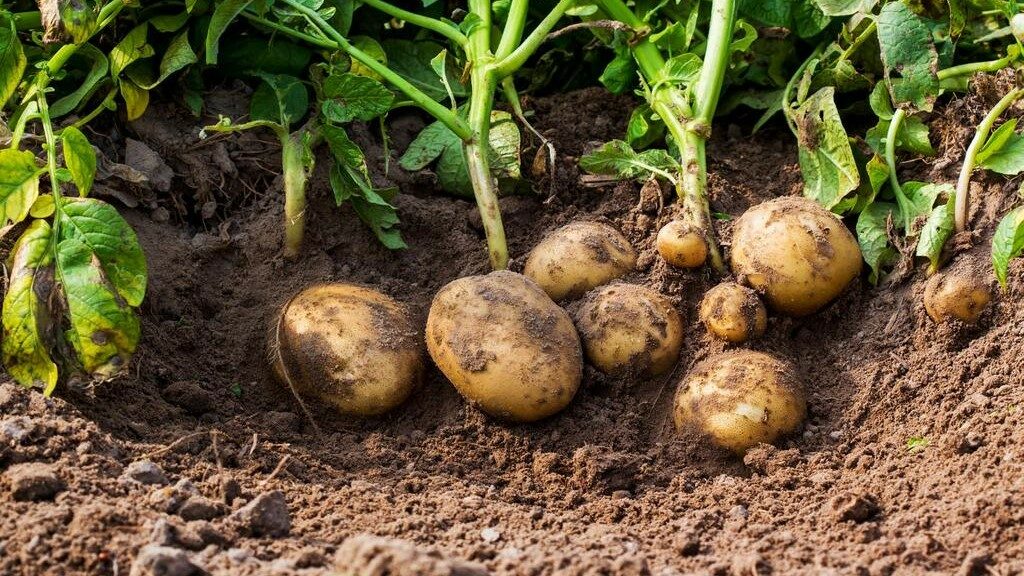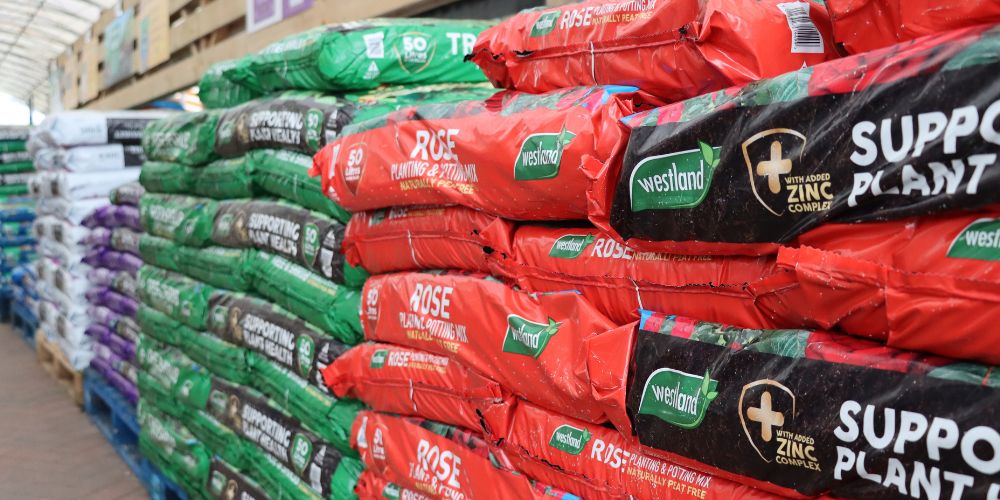Why not grow your own potatoes? Not only will you save a lot of money but you will also have a reliable source of unadulterated, freshly dug potatoes. Hugely versatile, potatoes can be roasted, mashed, chipped or baked – and are a real summer treat when freshly dug and lightly boiled with mint.
There are four main types – first earlies, second earlies, salad and maincrops depending on when they are planted and harvested; grow all four types to enjoy potatoes all summer, and store maincrops over winter. If you have plenty of space, you can go for both the early and the maincrop. Should your plot be small, then early are the answer and will provide new potatoes at a time when shop prices are high. We sell only certified stock, and we try to offer the widest range available up to 28 types in the peak selling season.
YIELDS
PREPARING THE SITE
Choose an open position in full sun on fertile, well drained soil. Avoid soil where potatoes have grown for two years in succession as this will increase the risk of disease. A slightly acidic soil is preferable but not essential. When growing potatoes on more alkaline soils, apply sulphur to the top of the potato ridge after planting. This maximizes the yield and deters skin blemishes like Common Scab that are particularly troublesome in alkaline conditions.
Prepare the planting site in November/ December to allow the soil to settle. Remove all weeds and large stones, dig the site thoroughly, incorporating plenty of well rotted organic matter and high potash fertiliser.
SETTING OUT
Early and second early seeds benefit from ‘chitting’ prior to being planted. This process encourages strong shoots to sprout over several weeks to encourage faster growth and heavier crops once they in the ground. From late January/ February, ‘chit’ your seed potatoes by setting them out in egg boxes or trays. You will notice that the immature ‘chits’ are all on one side (called the rose end). Place the rose end upwards. Keep them in a light (not sunny) frost free room.
Plant when shoots reach 2.5cm. Choose a sunny site away from frost pockets as frost can damage the foliage. Cover shoots with soil or fleece for protection and to keep light away (light turns the developing potatoes green and green potatoes are poisonous)them out in seed trays, shallow boxes or empty egg cartons in a cool, bright, frost free position to allow them to sprout.
PLANTING
You can plant potatoes in practically every soil type. In the established vegetable plot, potatoes should not be grown on land that has been used for this crop within the past two years. Before planting, break down any clods and sprinkle fertilizer over the surface.
Plant seed tubers from mid-late March outdoors for first earlies (late February under fleece or in pots under glass), early/mid-April for second earlies and mid/late April for maincrops. Plant approximately 10cm deep and 30cm apart. Allow more space for maincrop than earlies.
GROWING
-
There are several methods that can be used when growing potatoes at home:
- Trench method: Dig a narrow trench 12cm deep, lined with compost or grass clippings for a better crop. Space seed tubers at 30cm intervals in rows 60cm apart for earlies and 37cm intervals in rows 75cm apart for maincrops. Slugs can be a problem so you may wish to use a deterrent. When stems are about 23cm high, carefully draw soil up and over the stems to produce a flat-topped ridge about 15cm high. Called ‘earthing up’, this protects stems from late frosts which blacken the shoots and delay production and encourages tuber growth. Simply draw some soil over the top of the shoots to cover them again. First early and second early crops particularly require plenty of water during prolonged dry weather especially when tubers are starting to form. When the stems reach a height of 23cm (9″) above ground they should be earthed up again to prevent tubers near to the soil surface from turning green.
- Polythene method: Tubers planted through black polythene crop just below the soil surface with no need for earthing up or deep digging.
- Container method: Plant seed tubers in a large container with the bottom 15cm lined with potting compost. As new stems grow, keep adding compost until the pot is full. Water crops well in dry weather, especially when in flower and the tubers are forming. A fortnightly liquid feed of a balanced general fertiliser can increase yields.If there is still a danger of frost when the shoots have begun to emerge, draw a little soil over them for protection.
Spray, if necessary, against blight in humid conditions and if greenfly becomes numerous. Scab can appear in dry weather, particularly on quick drying soils. It does not spoil the taste or infect the soil. To avoid scab, water when dry.
HARVESTING
With earlies, wait until the flowers are fully open. Carefully remove soil from a small section of the ridge and examine the tubers. They are ready for harvesting as new potatoes when they are the size of small hens’ eggs.
With maincrops for storage, cut off the haulm once the foliage has turned brown and the stems have withered. Remove the cut haulm and wait 10 days, then lift the roots and let the tubers dry for several hours. Place them in a wooden box or dry paper or hessian sack and store in a dark cool frost-free place. They should keep until spring.
When harvesting, remove all tubers from the soil no matter how small to avoid problems next year.
FIRST EARLY VARIETIES
-
First Earlies are planted between February and April and harvested between May and July. They are often called new potatoes as they are ready to harvest before other varieties, around 9-14 weeks after planting. They produce lots of tasty, small potatoes.
- Arran Pilot: Very early traditional potato, bred on the Isle of Arran and the most popular variety in the UK in the 1930s. Excellent yield and flavour.
- Duke of York: Traditional early variety, harvest when young for a rich sweet flavour or leave to mature for a floury texture. Makes excellent baked potato.
- Foremost: Foremost remains popular as a new potato with slightly waxy, firm white flesh and an excellent flavour.
- Maris Bard: First early variety that bulks early. It is high yielding and has high potato numbers.
- Pentland Javelin: First early variety with good eelworm (golden) resistance. Very bright with a mild flavour.
- Red Duke of York: A traditional red-skinned variety with a yellow flesh. Makes excellent roasts.
- Rocket: Recent variety, throws a large number of round whole potatoes. Early variety with good disease resistance.
- Swift: Exceptionally early variety which produces lots of small round potatoes. It has partial resistance to both golden and white eelworm.
SECOND EARLY VARIETIES
- Estima: Very popular variety with farmers. Large yields with early bulking properties and good drought resistance.
- Kestrel: Attractive whole skins with purple eyes. Makes excellent chips and roast potatoes. Good resistance to blackleg and slug damage.
- Maris Peer: Popular second early potatoes with a very good flavour. Are good as salad potatoes. Plant produces large clusters of pretty purple flowers.
- Nadine: Exceptionally high yielding variety with bright white skins and a good entry for the show bench.
- Wilja: A high yielding variety with a russet skin. Will grow successfully in any type of soil and makes very nice tasting mash, baked and boiled potatoes.
SALAD VARIETIES
-
- Charlotte: A must have in the garden for a early salad potato crop. Very attractive long potato with an unbeatable creamy flavour straight from the garden to the pot!
- International Kidney: Exceptionally good eating salad potato straight from the garden.
- Pink Fir Apple: Popular in Victorian kitchen gardens this knobbly salad potato has an unrivalled nutty flavour. Cooking with the the skin on will retain its pink skin colour.
MAINCROP
- Cara: Big-yielding variety with an attractive skin. Good resistance to blight and is good for long term storing. Plenty of size and is a good one to grow for a baker crop.
- Carolus: Fully blight resistant variety that has an attractive appearance. It is ideal for growing in an organic plot. It has a good level of dry matter making tasty roast potatoes and fluffy mash potatoes.
- Desiree: The most popular red-skinned variety in the UK giving great crops of large potatoes. Regularly seen on TV being used by celebrity chefs. A good culinary potato which boils well and has a delicious smooth texture.
- King Edward: A well known favourite in the potato world. Attractive white skins with bright splashes of red. Makes the ideal roasts and baked potatoes but is also good boiled with a strong, aromatic flavour.
- Maris Piper: Probably the best known potato in Britain and one of the most versatile with an attractive plant with purple flowers. The potatoes taste great as chips, mash, roasts or simply boiled.
- Maxine: Red skins and waxy white flesh. A heavy cropping, maincrop variety and good all-round cooker.or cooking. Long oval tubers with yellow skin and red eyes.
- Pink Gypsy: Be the envy of the show bench with these attractive potatoes. Pink & white skins. Early maincrop with great disease resistance. Excellent flavour.
- Valor: An all-rounder that cooks every way and tastes great with the added bonus of having good disease resistance.








